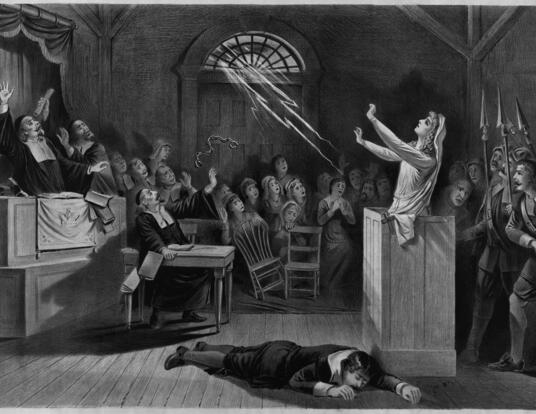Harvard Horizons Podcast: Cracking the Tate

Research at Risk: Since World War II, universities have worked with the federal government to create an innovation ecosystem that has yielded life-changing progress. Now much of that work may be halted as funding is withdrawn. Find out more about the threats to medical, engineering, and scientific research, as well as how Harvard is fighting to preserve this work—and the University's core values.
For nearly as long as there has been art, there have been technicians in the background who enabled the artist to realize her creative vision—from those who prepared paint to those who quarried marble, made canvas, built galleries, and constructed museums. The size and scope of contemporary art, however, have made these technical specialists even more critical to the creative process—and more of a part of it. In this episode of the Harvard Horizons podcast, recent PhD graduate Hannah Cohen sheds light on the work of these craftspeople through a look at one of the century's most arresting works of art: Shibboleth, an installation that involved cracking the foundation of London's massive Tate Modern museum.
This transcript has been edited for clarity and correctness.
In October 2007, the Colombian artist, Doris Salcedo, set a crack down the center of the Tate Modern. The crack, called Shibboleth, quite literally broke the museum in two. It took a stab at an institution with deep historical ties to British colonialism, as well as a long history of overlooking artists like Salcedo, who at the time, was only the second female artist, and the first artist from the Global South to ever be invited to produce new work for this particular space.
Salcedo's proposal was conceptually a radical one, but it came with a major hitch. No one could figure out how to do it. Cutting directly into the concrete floor of the building was out of the question, as it stood to compromise the structural integrity of the museum.
But so is the next obvious alternative, laying a cracked concrete slab over top the floor, as this was so transparent in the method of its staging, that is, to compromise the effect of the work on the viewer. In the lead-up to the exhibition, Salcedo and her team worked for weeks on end to no avail to try to figure out how to break the Tate. And in the end, the person who figured out how to do it was none other than an engineer by the name of Stewart Smith who worked for the very same company that had engineered the building in the first place.
Shibboleth is a fascinating work of art, and it exemplifies something crucial about contemporary art more broadly. This is an artwork that is inextricable from the technical feat of its production. The reason this work works is because Smith engineered it with such care and finesse that his contributions entirely disappear into the fabric of the work itself.
We often think about art in romantic terms, as something privileged and pristine, something removed from the fabric of everyday life. But the fact is, it's anything but. It's technical.
In my research, I look at the ways in which technical specialists, technical systems, and technical knowledges invisibly proliferate the world of contemporary art. And the reason why I do this is to explore this ideological tension between the idea of art and its construction. The first focus of my research is technical specialists, in particular, the figure of the engineer.
All appearances to the contrary, museum and gallery spaces are highly technical environments. In order to meet the conservation standards of historical works of art, as well as the display requirements of more contemporary artworks, many of which are quite large or technically complex, museums must have in place cutting-edge mechanical systems to regulate heat and relative humidity, lighting systems, to light galleries without exposing artworks to harmful wavelengths, and structural systems able to support the unusual point loads of heavy artworks. And on top of all this, all of these systems have to be so carefully integrated with one another that they can be entirely concealed within the space itself.
This work is done by engineers, and in particular, the engineers of one company, the London-based firm, Arup. On this world map, each glowing dot corresponds to just one of the many, many museums that Arup has engineered. In my research, I examine what the complexity of engineering art entails in the specific case study of the Tate Modern.
Drawing on archival materials, as well as extensive interviews with engineers themselves, what I argue is that these engineers aren't just making calculations. They're really setting in place the very conditions of what contemporary art is and what it can become. They're thinking to themselves, OK, I have to design a museum that will be able to stand the test of time, that will be able to exhibit artworks that are so new they haven't even been imagined yet. And then they're basically putting on their art history hats, and mining arts history to make determinations about what contemporary art is, and how it's evolving, and then baking those projections into the museums that they design.
In this way, just as the display requirements of past works of art come to inform the technical design of new museums, so do the technical conditions of display come to inform the parameters for the evolution of new art. If we think about museums as machines for art, machines have many parts or systems. And one of the most important systems that any museum has is its wall system.
The white cube is the paradigmatic modern and contemporary exhibition space. It's white. It's skylit. It seems almost like a sacred space. It's why by the old joke you walk into a modern art gallery and you think the fire extinguisher is a work of art. Art seems like art, like something sacred and timeless, because it's shown in this particular type of space.
An unusual aspect of this architectural typology though, is that from the start, these spaces that are meant to convey an eternity of display are in fact, entirely temporary. They use mobile and temporary wall systems to reconfigure spaces anew for each new show. And the reason why this matters is because contemporary art is art that's new and always changing. And so museum and gallery spaces have to be able to spatially accommodate this sort of temporariness in flux.
In my research, I chart a history of museum walls and wall systems, which as you can see, can be surprisingly technical, and are always idiosyncratic to their respective institutions. And I look at them as technologies by which museums negotiate this essential tension between the idea of art on the one hand, which is upheld by the white cube and its pretense of permanence, and on the other hand, the practical requirements of exhibiting art that's new and always changing. The final focus of my research is technical knowledge, a ubiquitous presence throughout the world of contemporary art, albeit, a way of knowing that stands at a profound distinction from how art is conventionally understood.
We often think about art as something that's visual. You go to a museum, for example, to look at art. But contemporary art can confound even the most astute powers of visual analysis. What makes a pile of wrapped candies or a trash bag-covered canvas art are concepts, ideas, and academic frameworks that theorized these objects as art.
One of the central sites I look at in my research is the Walla Walla Foundry in Eastern Washington State. The Walla Walla Foundry is one of the world's largest commercial producers of large-scale contemporary art. It makes artworks such as these, which can sell for upwards of $1,000,000 apiece.
On-site at the Foundry workers come to know art not by reading about it, or by studying it, but by making it by direct technical engagement with art itself, by molding it, modeling it, casting it, welding it, painting it, creating it, accruing a substantial, if pretty unusual knowledge of art in the process. Drawing on extensive interviews with workers on site, what I argue is that contemporary art is sustained by two very different ways of thinking and that the technical knowledge that materially sustains art might actively contest, if not outrightly critique the more academic frameworks that conceptually sustain it.
To take stock of the technics of arts production and display is to confront the complex ways in which the concept, and vision, and value of art are all quite literally constructed by persons, systems, and knowledges that don't fit naturally within how we are taught to think about art, or how we experience it in a gallery setting. Our contemporary cultural landscape is indelibly shaped by non-cultural actors. And these actors don't make art any less fascinating, or beautiful, or important, but they do make it more complex in ways that demand we rethink its place in the world around us.
Get the Latest Updates
Join Our Newsletter
Subscribe to Colloquy Podcast
Simplecast




